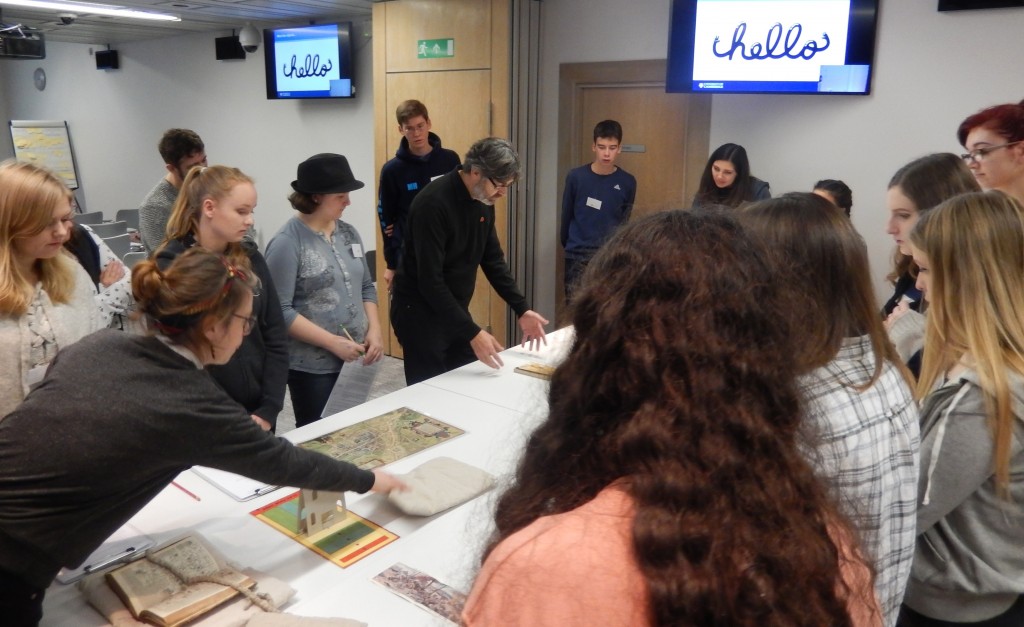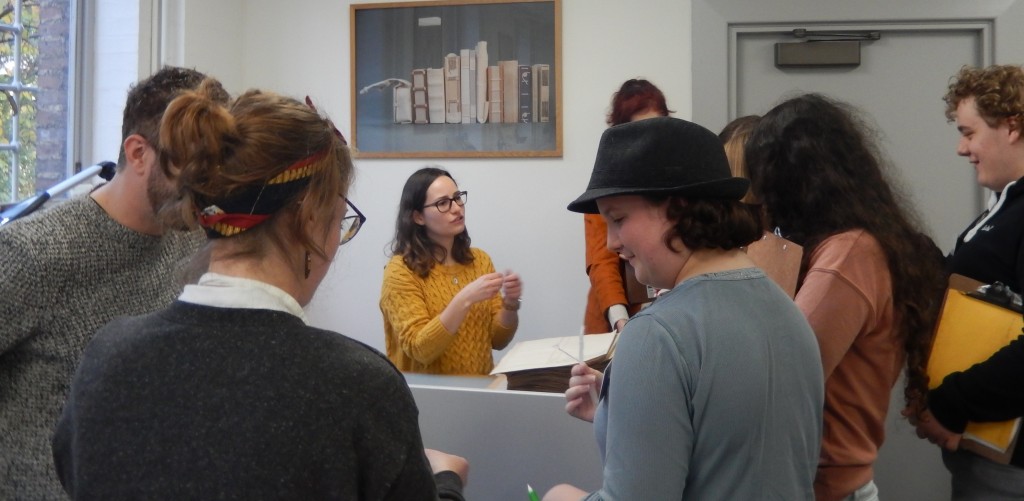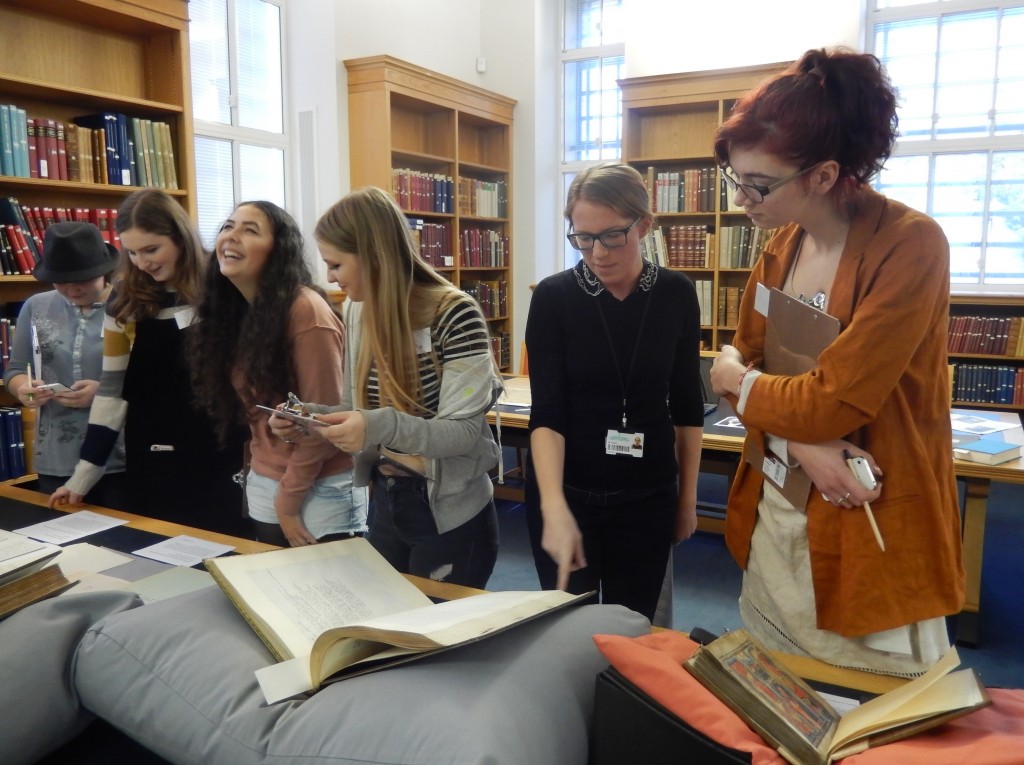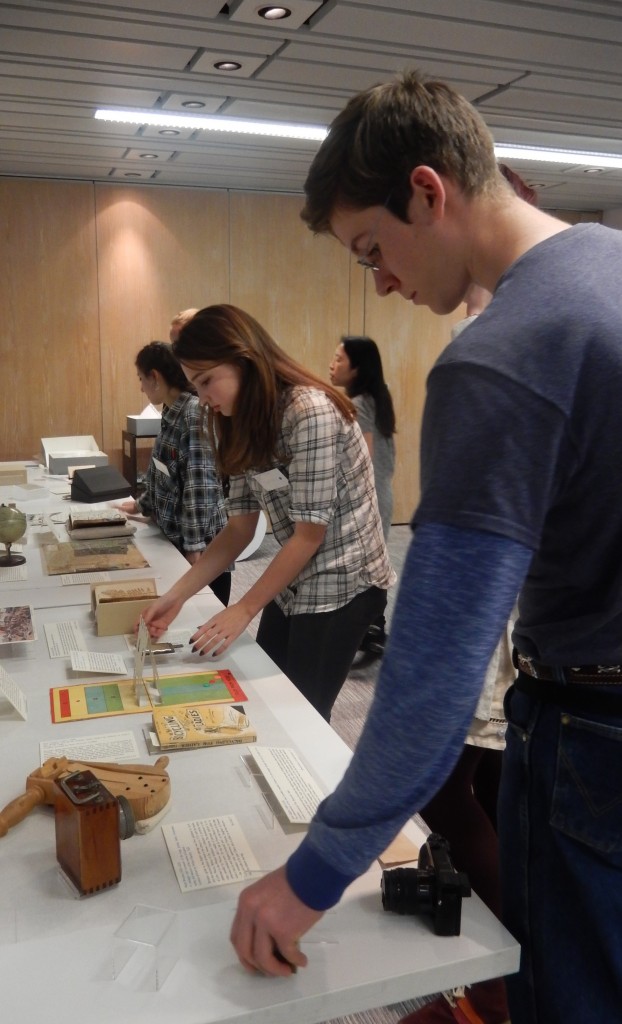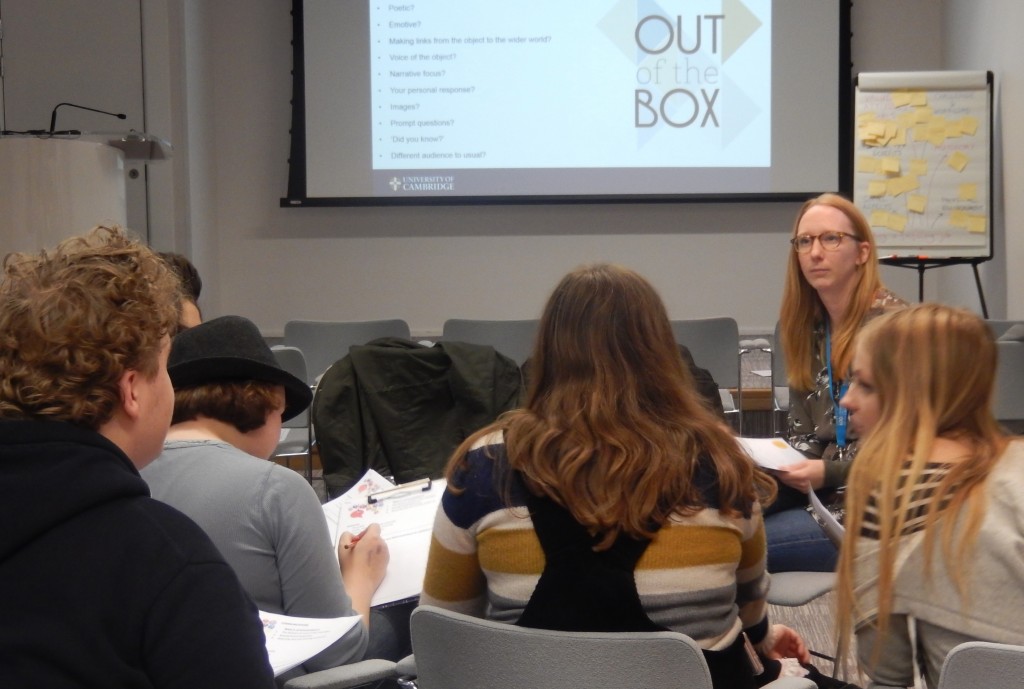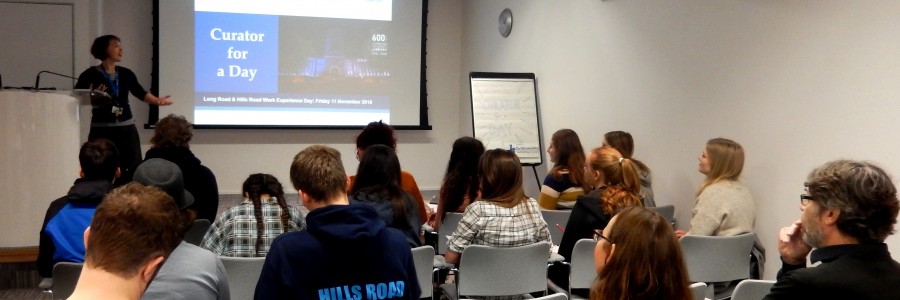
Curator for a Day
In November a group of thirteen students from Long Road and Hills Road Sixth Form Colleges in Cambridge spent a day being curators in the University Library, as part of a project supported by the Heritage Lottery Fund. They met staff in a number of specialist departments, learning about issues including conservation and digitisation, before putting together a display of books and objects (chosen in a public vote) which features in the Entrance Hall cases until 10th December (and online). It complements the Library’s main Curious Objects exhibition, which tells the story of the Library’s six centuries through some of the more unorthodox artefacts which have found their way into its collections. During their day as curators half of the students grappled enthusiastically with the logistics of how things might best be displayed, while the others created the captions. The idea was to break free from the shackles of the traditional museum caption—so focussed on provenance, creators and content—in order to be personally inspired by the objects they handled. The physical exhibition is also represented by an online display, but here we share some of the students’ reflections on their day as curators at the University Library.
Sophie Wilkinson: I really enjoyed being a part of ‘curator for a day’. It was great to learn about all of the different jobs in a library, such as conservation and the rare books department. In particular, I found creating our exhibition very interesting as I didn’t know about the process of writing the labels or designing the layout before the day, so that has taught me to appreciate exhibits a lot more. I was amazed at how the library’s 8 million books fitted in the building; there were even bookshelves in the corridors! Overall, it was a lovely day and all of the staff were very friendly and welcoming, so I am very grateful for this experience.
Sarah Garrod: A couple of weeks ago I had the opportunity to visit the University library and be a ‘curator for the day’. I’d only signed up for this the day before and had no idea what to expect, but it ended up being a thoroughly enjoyable experience. We started off by writing three things that were important to us in a job and sharing that with the group of other students (for example stability or good pay). Being the awkward anarchist I am and not fully understanding the task, announced that I wanted to otherthrow the bourgeoisie and establish anarchism. The rest of the day was spent touring the University Library and its various departments, discovering that I’m rather useless at mapping, and seeing artefacts being restored and photographed. The highlight of my experience was writing labels for our own collection of artefacts, as I wrote a (not too shabby) poem about imperialism as a label for an old globe biscuit tin. Overall, everyone involved had a great experience and learned a lot, talking about it for days after. Special thanks to everyone involved and Rosie for making this a memorable day (sorry for stealing all the M&S bourbons!).
Jasmine Cartwright: I thoroughly enjoyed my day at Cambridge University Library! I had never been to any library on such a scale and I was purely amazed at how much was there. I enjoyed learning about all of the different jobs (that I didn’t even know existed before I went!) and I found the whole day fascinating. Every member of staff was completely welcoming, the Jaffa cakes were amazing and it’s really opened my eyes to some different types of jobs! Thank you!
Matthias Hargrave: Have you ever wondered what it takes to prepare a museum or library exhibit? Or maybe what on earth you might be able to do at a library for a living? Well, on the 11th of November a group of Sixth Form students were given the opportunity to see behind the scenes in the University Library. This didn’t just involve touring the separate departments, but also actually putting together a mini exhibition!
Personally my favourite part of the day was the Manuscripts and Archives department. I love books, and old, historic books (or letters) are the best, so this department was exactly my type. In the tour we were given a brief introductory to the department (who wants a long introduction when the books are waiting?) then there was a large selection of books and archived files, letters and more that we could browse at will! These included a logbook from one of Captain James Cook’s ships from his Pacific voyages. It was filled with navigational information recorded almost hourly at times as well as maps and sketches of the islands they visited. As a sailor and avid history fan, the navigational information was of great interest to me as were the detailed descriptions of Easter Island.
Overall it was an amazing time that I would highly recommend to anyone interested in books, history, anything remotely related to a library, or anything else! I am not a humanities or arts student in any way, considering that my A-levels are sciences and maths, but I still had a wonderful time. So, even if you don’t think that books are really your thing, you may discover that there is much more to a library than you might think!
Holly Bootman: Cambridge University Library is the centre of gravity for books. Walking through the corridors you find yourself immersed in a culture of language, literature and history. Delve deeper, and you can see the thousands of precious manuscripts, maps and artefacts stored and presented carefully for visitors and researchers to examine. With so many departments working to preserve and collect these valuable items, my day at the UL showed me that there is no limit to the ambition of the staff to grow and share the incredible information that their collections reveal about the world.
Our day began looking around the ‘Curious Objects’ exhibition, where we saw some intriguing artefacts that had come from a range of cultures and periods of history. We were then introduced to some items that hadn’t made the exhibition, but were equally fascinating and curious. Later we were to help curate these artefacts to be presented in a smaller exhibition – a daunting but exciting task. The departmental tour revealed a lot about life at the UL, and it seemed that in every department you would find dedicated and engaging people who were extremely knowledgeable about their area of expertise. Our group started in the Rare Books department, which specialises in the collection of unique and important books, manuscripts and pamphlets. I was intrigued to learn that books are continuously being collected, even books with topics as recent as Brexit, to ensure that future generations can develop a good understanding of the world as we know it today, which is something that I feel is of extreme importance. We then went on to visit the Conservation department, which is partly a hospital for injured books, and a place where artefacts are examined, restored and displayed so that they can be fully appreciated by the public. There we had the opportunity to look at a book containing some of Charles Darwin’s experimental work, and we were also able to see some documents which recorded the distressing events that took place in Singapore during WWII. I felt that I was beginning to understand the importance of conservation and the relevance of libraries in the modern day. Events in the past mustn’t be forgotten, and we must continue to learn from history. How else can this be done without evidence and contemporary resources?
I also found it interesting that the library is continuously expanding its collections and modernising the way that items are presented and shared. For example, the Digital Content Unit is working to build an online database of artefacts and books to enable a wider audience to access important and exciting resources. This is something that I thought had great significance, as I could see how unique materials are becoming increasingly inclusive and accessible.
Each department we visited had a different focus, but it became easier throughout the day to see the links between branches, and by the end I felt that I had a far better understanding of the process of curating objects. Following the departmental tour, we completed the labels for the objects in the exhibition, and it struck me how the artefacts represented the work of every department we had visited, and every part of the curation process we had experienced that day. My day at Cambridge University Library has enabled me to acknowledge the importance of conserving materials that provide us with invaluable information, and has taught me to appreciate the variety and range of resources that have been made available through years of research and dedication.

